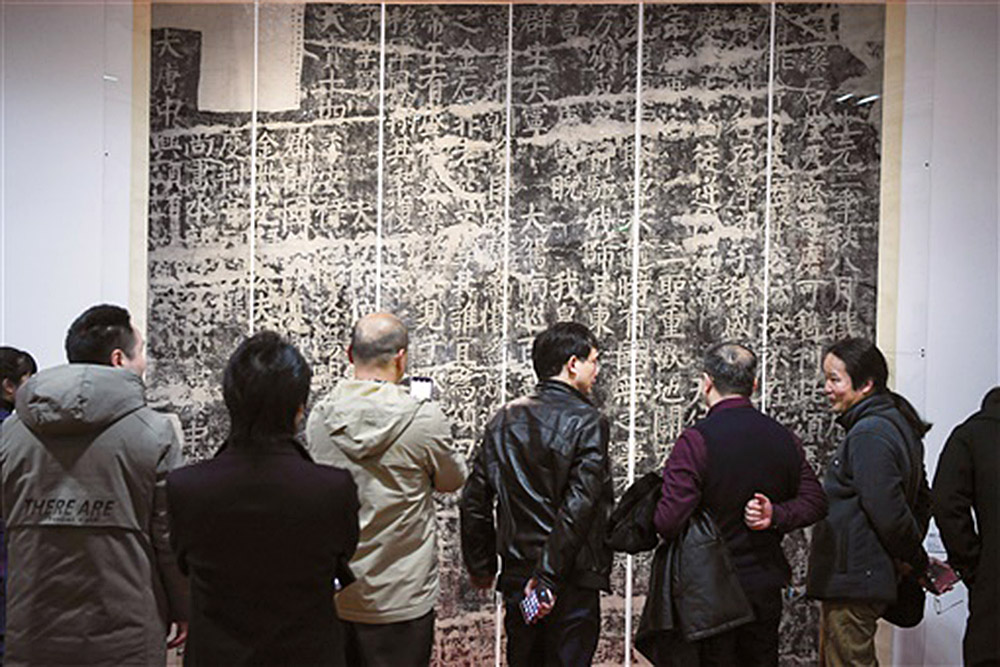
On March 20, the Hunan Classics — Thousand Years of Hunan Calligraphy Exhibition opened at the Meilun Art Museum. Even the endless spring rain couldn’t dampen the visitors’ spirit.
The exhibition, organized by the provincial Federation of Literary and Art Circles and Hunan Art Publishing House, is composed of three parts: Ancient Calligraphy of Hunan (late Shang Dynasty – 1644), Hunan Calligraphy in Qing Dynasty (1644-1912), and Hunan Calligraphy in the Republic of China and Modern China (1912-2000), comprising more than 2000 pieces.
The most ancient exhibit is a 3000 years old national treasure known as Min Fanglei, unearthed in Taoyuan, Hunan province. Min Fanglei is a representative artifact from the golden age of bronze vessels in the late Shang Dynasty. Its strong and dignified inscriptions, still very close to pictograms, serve as a solemn preface to the exhibition.
The Chu state of the Warring States Period formed its own style, different from the “both head and tail slightly sharp” strokes of the inscriptions of the Shang – Yin Dynasty. The characters of the Chu Silk Manuscripts from Zidanku, Changsha, and the Chu Cili Slips are rounded and curvy, the forms are slightly uneven, the style has a mellow and elegant feel. Characters’ strokes of the Liye Qin Slips strokes are careful and deliberate, the long tail of the final stroke at the lower right makes it look neat and well-spaced. The so-called “wavy” long downward stroke of the lishu script is more leveled and smooth at the Gulang stele from Leiyang of the Three Kingdom Period and the Lady Cao stele of the Eastern Jin dynasty. Characters look more flattened and squared. These pieces captured the evolution of the calligraphy from clerical to regular script. Three out of ten famous stone steles are located in Hunan, namely the Zhongxing stele in Wuxi, Qiayang, the Lizi stele in Liuzi Temple in Yongzhou, and the Suxiangling stele in Chenzhou. The exhibition allows you to see all these wonders with your own eyes.
The works by the Tang calligrapher Yan Zhenqing, the regular script calligraphy by Ouyang Xun, and the cursive script calligraphy by Huai Su vividly and thoroughly demonstrate the spirit of the Hunan culture, with its laws and freedom, reason and passion. Calligraphy by Su Shi, Huang Tianjian, and Mi Fu shows the fine literary attainments of the people of the Song Dynasty, as well as the characteristics of the time of capturing emotions and ideas.
With the rise of the research of metal and stone inscriptions of the middle Qing dynasty and unearthing of the stone tablets of Han and Wei dynasties, calligraphers of Hunan were able to learn from the past and form a strong and vigorous calligraphy style. He Shaoji, Wu Dacheng, Wei Yuan, Zeng Guofan, Zuo Zongtang, Peng Yulin, Hu Linyi, Tan Sitong……all these people who shaped the modern history of China were also great calligraphers, whose works spark the majestic and courageous spirit of “being sage inside and being kingly outside”.
Artworks by 17 calligraphers of the Republic of China were selected for the exhibition, including Qi Baishi’s teacher Wang Kaiyun, the leading figure of the Shanghai school Zeng Xi, Premier Minister of the Beiyang government Xiong Xiling, martyr of anti-japanese resistance Zheng Jiagai, leader of Xinhai Revolution Huang Xing, famous warlord of modern times Cai E. The works of two brothers and calligraphers Tan Yankai and Tan Zekai from Chaling are also currently on display.
The exhibition presents the works of 6 calligraphers of modern period. As a representative figure of the transitional period of the modern painting, calligraphy, and seal carving style, Qi Baishi in his seal script and official script works was inspired by stone tablets of Qin and Han dynasties and infused it with the down-to-earth style of the folk art. His running script fan calligraphy has lively and irregular composition. The great leader Mao Zedong is recognized in calligraphy circles as a great calligrapher of the 20th century, his bold, dynamic, and vigorous style is highly esteemed. The great scholars Zhang Shizhao, Yang Shuda, Qian Jibo, and Shen Congwen also played an important role in the history of calligraphy.
The exhibition presents a wide variety of styles and formats, covering such fonts as Large and Small Seal scripts, Old and Han Clerical scripts, Large and Small Cursive scripts, and semicursive Running script, the abundance of writing materials such as ink, stone, bamboo and silk and the diversity of formats including central scroll, couplets, fans and letters. The variety of styles creates a clear, three-dimensional, panoramic view of the overall context of the evolution of Hunan calligraphy and shows the continuity, innovation, and profound cultural heritage of Hunan calligraphy styles in the past generations. The Hunan calligraphy dates back thousands of years and so far it has been a magnificent view.
The exhibition will last until April 10 and is open to the public free of charge.
It is worth mentioning that the Hunan Classics — Thousand Years of Hunan Calligraphy exhibition is part of the Hunan Classics project by the Hunan Federation of Literary and Art Circles. The project consists of two parts: publications and exhibitions. Ten books have been published as part of the project, namely: Hunan Stone Inscription Calligraphy, Hunan Bamboo and Silk Calligraphy, Hunan Ancient Calligraphy, Hunan Modern Calligraphy, Hunan Seal Carving, Ouyang Xun Calligraphy, Huai Su Calligraphy, He Shaoji Calligraphy, Qi Baishi Calligraphy and Seal Carving. The exhibition part of the project is represented by the current exhibition Thousand Years of Hunan Calligraphy.
Photo courtesy of the Hunan Daily — Voice of China Online reporter Gu Pengbo
By Chen Wei, Hunan Daily — Voice of China Online reporter
